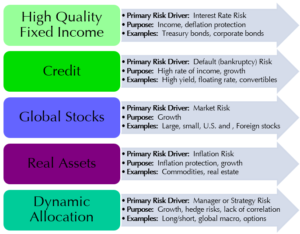Looking Toward the 2nd Half of The Year: Asset Allocation Views
July 1, 2022
To Inform:
Earlier this week The Joseph Group’s Investment Committee (IC) met and discussed market thoughts for the second half of 2022 and how we want to position client portfolios across asset classes.
The backdrop for the discussion was the idea markets are likely to be stronger later in 2022 (see last week’s WealthNotes) but acknowledging the biggest risk seems to have shifted from geopolitics/inflation to recession.
First a bit of background. When we talk about asset allocation across diversified portfolios, we divide asset classes across five key categories. Each category plays a different role (purpose) in the portfolio when it comes to achieving client objectives. Each category also has a different primary risk driver which is the key factor which makes that category move up and down in various market environments. Each of the objective-based portfolios we have the privilege of managing for clients starts with a “neutral” position across these five categories which should allow the portfolio to achieve its objective across a full market cycle. We then “underweight” and “overweight” asset classes relative to the neutral target in order to seek opportunity and/or manage risk.

Source: The Joseph Group
Let’s take a look at how we are approaching these asset classes as we enter the second half of 2022:
- High Quality Fixed Income (Bonds) – Adding Exposure (less underweight): We entered 2022 with High Quality Bond exposure at a maximum underweight relative to long-term targets. Why? We believed record low interest rates called for record low bond exposures. Fast forward to today, interest rates have moved from historically low levels to the highest levels in decade. As a result, we are increasing exposure to high quality bonds. Compared to the beginning of the year, bonds are paying more income, the higher income provides a cushion against further rate increases, and if we enter a recession, bonds are better positioned to provide ballast to a portfolio. Overall, we are still underweight relative to neutral targets, but the higher interest rates go, the more comfortable we are adding to bonds.
- Credit (High Yield/Junk Bonds) – Slight Underweight: High yield bonds are riskier than high quality bonds and as a result, they pay an additional amount of interest to compensate investors called a “spread.” Today, the spread on high yield bonds is 5.8% (source: Wall Street Journal Market Data Center). When we add that spread to the current 5-year Treasury bond rate of 2.9%, it means High Yield Bonds are paying interest rates of (2.9% + 5.8% =) 8.7%. That’s a pretty attractive income return and if markets simply grind sideways, High Yield Bonds may be the best performing piece of portfolios. However, if the market moves further toward recession, the spread on high yield bonds may increase further. We like the income, but we believe it’s too early in the cycle to overweight exposures.
- Global Stocks – Neutral: Our neutral view on stocks is predicated again on the belief markets will improve later in 2022 but acknowledging the risk of recession. Our neutral view though doesn’t mean simply buying the index – currently our mantra is “dividends, dividends, dividends.” We’re looking at dividends as a “catch-all” term which includes stocks which have high quality, a value-style and lower P/E ratios. We believe companies which can generate cash flows and pay out those cash flows to shareholders will be rewarded relative to companies which have a higher dependence on capital markets. We also want to have a tilt within stock allocations to areas of the market which appear cheap. Today, that includes small cap stocks and foreign stocks. In a recent research report, JPMorgan said “small cap stocks currently trade near the lowest valuations in history.” And while foreign stocks so far this year are down as much as U.S. stocks, about half of that decline is due to the rising value of the dollar. Foreign stocks themselves (without the currency impact) are outperforming and if the dollar stabilizes, it could be a tailwind to foreign stock performance.
- Real Assets – Remain Overweight but Rebalance: As inflation has surged, commodities have been a bright spot in diversified portfolios. However, we believe we may be shifting from an environment of accelerating inflation to simply inflation which is sticky at a high level. Think of a car which is no longer accelerating, but going at constant speed of 70 mph – that’s a good analogy for how we are thinking about inflation. We want to rebalance our real asset exposure to take profits in commodities but add exposure to areas such as real estate and infrastructure which can benefit from inflation-adjusted cash flows. We are also maintaining exposure to gold within certain portfolios which we believe can act as a hedge against geopolitical risk while potentially benefiting from a next phase to the inflation story.
- Dynamic – Reduce Exposure (Neutral): The “Dynamic” portion of portfolios is where we use strategies which may hedge stock market risk, interest rate risk, or other exposures, but puts more of an emphasis on individual manager or strategy risk. Within certain portfolios we are reducing exposure to hedged equity strategies which have worked to provide cushion against recent market declines. We are using the shift to add exposure to bonds (as a recession hedge) while also have more direct exposure to stocks in order to maximize the potential to benefit if the market does rally later in 2022.
Each portfolio strategy we have the privilege of managing for our clients is tied to an objective and, as a result, each portfolio is treated differently in order to maximize the ability for the strategy to achieve its goal. We may be doing different things in different portfolios depending on the goal and the timeframe of the strategy. These asset allocation views are a starting point. We discuss our positioning across asset classes as a regular part of our Investment Committee meetings and make changes as valuations and market conditions change. In other words, as we are “driving the car” shifts in asset classes are part of how we speed up, slow down, and change lanes to help clients get to their destination. Markets have clearly been rough this year with most asset classes in the red. Looking forward however, higher interest rates and lower valuations are providing incredible opportunities for investors to achieve their long-term financial goals.

Written by Travis Upton, Partner, CEO and Chief Investment Officer